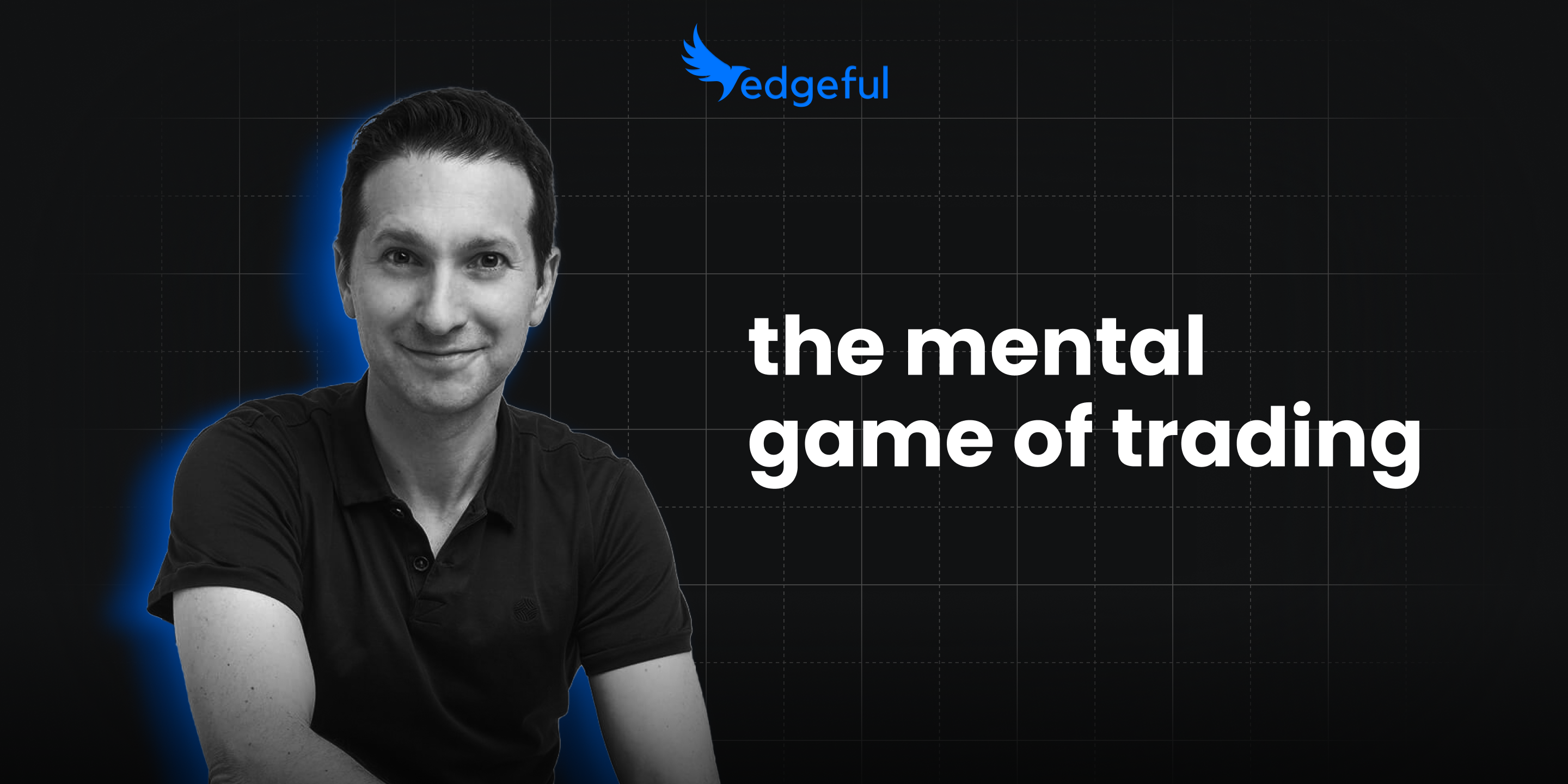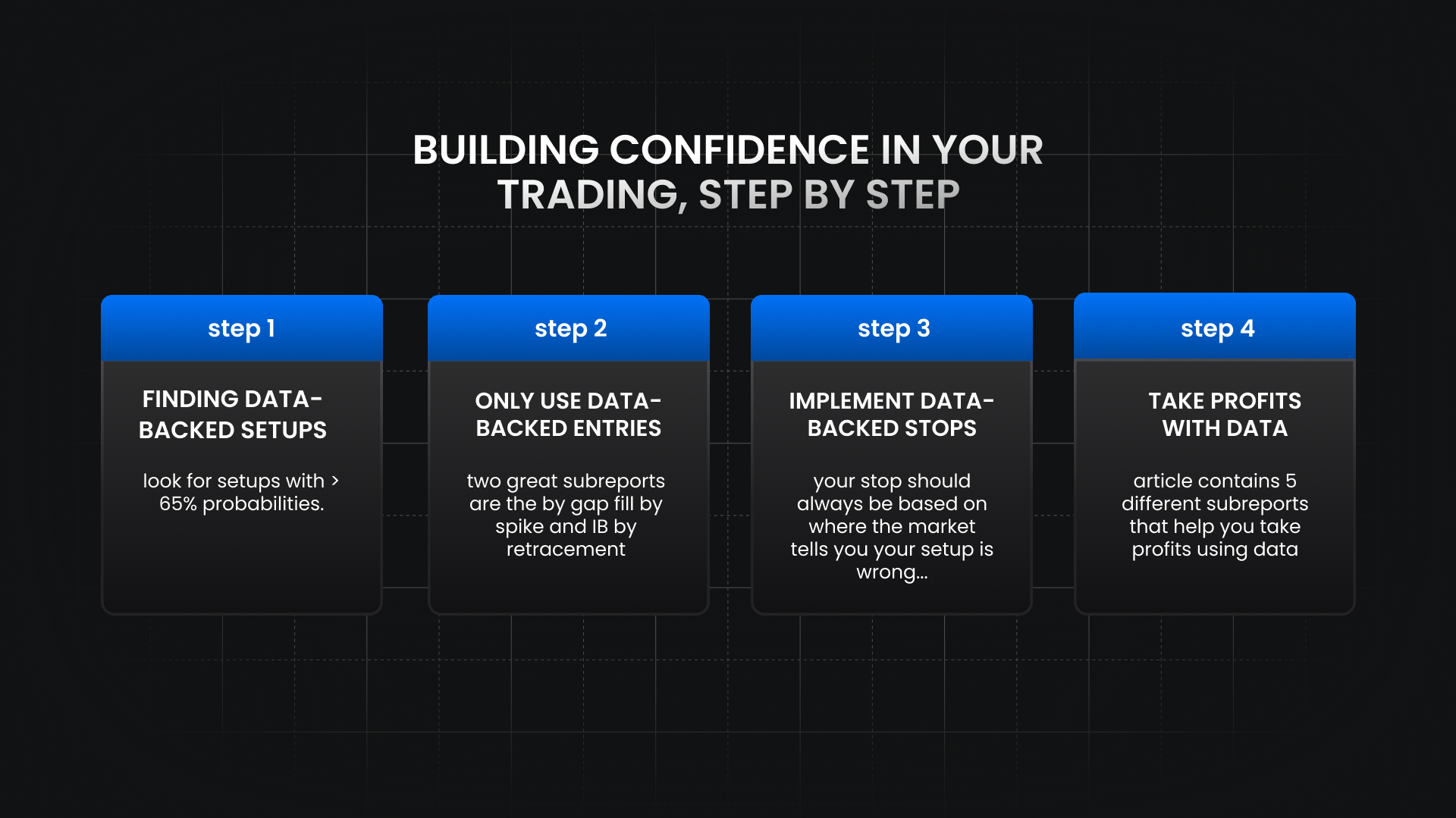Jared Tendler: the mental game system elite traders actually use

welcome back to stay sharp — our weekly newsletter where we dive into data-driven trading strategies that actually work.
last week, we covered Ray Dalio's principles and how legendary traders think differently about the markets. this week, we're going one level deeper into something that separates consistent winners from everyone else:
the mental game.
you've read the motivational quotes. you've tried the breathing exercises. you've told yourself "just be disciplined" for the hundredth time.
and yet, you still:
- exit winners too early
- hold losers too long
- ignore what the data is telling you
- overtrade when you know you should sit out
let me be blunt — you don't have a motivation problem. you have a system problem.
I want to introduce you to Jared Tendler's mental game framework that world champion poker players, professional golfers, and elite traders use to permanently solve their psychological issues.
Tendler's book "The Mental Game of Trading" is the most practical, actionable approach to trading psychology I've found."
no fluff. no "just think positive." just a repeatable system:
map → diagnose → correct → repeat.
why you need a system (not quick fixes)
here's the thing about conventional trading psychology advice...
it tells you to "control your emotions" — which is impossible when you don't even know what's causing them.
it gives you band-aid solutions like meditation, walking away from the screen, or trading smaller size. these aren't bad strategies, but they're just managing symptoms. you're not fixing the actual problem.
it treats the symptom, not the root cause.
Tendler's core idea: emotions aren't the problem — they're signals pointing to deeper performance flaws.
think about it. when you exit a winner early, the surface emotion is fear. but fear is just the alarm going off. the real issue — the thing creating that fear — is often something deeper like:
- perfectionism (you can't accept that some trades will reverse)
- fear of failure (you'd rather have a guaranteed small win than risk being "wrong")
- illusion of control (you believe you can predict when the market will turn)
- confirmation bias (you only remember the times holding turned a winner into a loser)
most traders spend years trying to "control their fear" when they should be fixing the perfectionism that's creating the fear in the first place.
Jared Tendler's 3-step system
Jarend Tendler breaks down mental game improvement into three distinct steps:

step 1: map your pattern
you can't fix what you can't see.
most traders know they have a problem (like exiting winners early), but they don't understand the full pattern of how that problem shows up.
mapping means identifying:
- your triggers (what situations cause your worst trading?)
- your signals (what thoughts, emotions, and behaviors show up before mistakes?)
- your accumulated emotion (why some days you lose control faster than others)
for example, let's say you struggle with exiting winners early. your map might look like this:
- trigger: trade goes 8 points in your favor
- thought: "what if it reverses and I give back these gains?"
- emotion: anxiety building in your chest, heart rate increasing
- behavior: mouse hovering over the exit button
- action: closing the trade with a "better safe than sorry" justification
Jared Tendler calls this mapping your pattern because you're gathering data on yourself, just like you gather data on the market.
here's what makes this powerful: once you can see the pattern, you can start catching it earlier. you'll notice the thought before you hit the sell button. you'll recognize the anxiety before it takes over.
recognition is a skill, just like reading price action.
step 2: diagnose the root cause
this is where most traders get it wrong. they stop at the surface emotion.
"I exit winners early because I'm fearful."
okay, but why are you fearful? what underlying belief or performance flaw is creating that fear?
common root causes:
- perfectionism — every trade needs to be perfect; a winning trade that reverses means you "failed"
- loss aversion — the pain of watching profits disappear is worse than the satisfaction of hitting your target
- hindsight bias — you remember that one time you held and it reversed, so now you're convinced it'll happen every time
- fear of failure — taking a small profit "proves" you made a good decision; holding for more risks being wrong
- illusion of control — you believe you can predict the exact moment price will reverse
the diagnosis step requires brutal honesty. this is what separates jared tendler's approach from conventional trading psychology — you're not just managing emotions, you're eliminating the root cause.
you have to dig past the comfortable excuses and find the actual flaw.
keep asking "why" until you hit something that resonates.
step 3: correct the problem
once you've identified the root cause, you create what Jared Tendler calls "Injecting Logic" — a correction statement that directly counters your specific flaw.
this isn't generic affirmation nonsense like "I am a disciplined trader." this is targeted logic that addresses YOUR specific performance flaw.
the four-part correction process:
1) recognize the signal — catch yourself when the pattern starts (this is why mapping matters)
2) inject the logic — use your specific correction statement to counter the flaw
3) take the correct action — execute based on logic, not emotion
4) repeat — you're training a new neural pathway through repetition
a real example — applying Jared Tendler's system to a the trader who kept exiting winners early
let me walk you through how this system works in practice.
the pattern: imagine you're a trader who consistently exits profitable trades way too early. you get into a setup that hits your entry criteria perfectly, the trade goes 8 points in your favor, and you immediately close it — even though your target was 20 points and the data shows this setup hits that target 68% of the time.
two candles later, the trade runs to 25 points without you.
or take this example — using our ORB algo from earlier this week.

clear entry criteria, and a clear data-backed target.
but instead of letting the trade play out, you get scared after seeing it go 20 points into profit, and then exit for breakeven - not worrying about the data or listening to the setup.
30 minutes later you’re sitting on the sidelines angry because you messed with a winning trade.
the surface emotion: fear. anxiety. the overwhelming urge to "lock in profits before they disappear."
but here's where most traders stop: they tell themselves "I just need more discipline" or "I need to control my fear." they set reminders. they put sticky notes on their monitor that say "LET WINNERS RUN."
and it doesn't work. because they're treating the symptom, not the root cause.
mapping the pattern (Tendler's step 1): if this trader used the Jared Tendler system, they'd start by mapping when this happens:
- trigger: trade goes into profit by 6-10 points
- thought: "what if it reverses and I give back these gains?"
- emotion: anxiety building in chest, heart rate increasing
- behavior: mouse hovering over the exit button
- action: closing the trade with a "better safe than sorry" justification
they'd write this down. multiple times. until they could see the full pattern clearly.
diagnosing the root cause (Tendler's step 2): the real flaw isn't fear — fear is just the signal. after some honest self-assessment, this trader realizes the underlying performance flaw is loss aversion combined with perfectionism.
they have an unconscious belief: "a winning trade that turns into a loser means I failed. I made a mistake by not taking profit when I had it."
the correction (Tendler's step 3): the trader creates an Injecting Logic statement that directly counters this specific flaw:
"this setup hits my 20-point target 68% of the time. if I exit at 8 points every time, I'm guaranteeing I underperform. I'm choosing to trust the probabilities over my need for certainty."
now, here's where the work begins.
every time that urge to exit early shows up — and it will, probably dozens of times — they catch it (recognition skill from mapping), and repeat the correction.
they feel the anxiety at 8 points. they notice the thought "what if it reverses?" they recognize their hand moving toward the exit button.
and they inject the logic: "68% of the time this hits 20 points. I'm choosing probabilities over certainty."
they do this over and over. for weeks.
the result: slowly, the pattern weakens. they still feel the anxiety at 8 points, but they catch it earlier. they remind themselves of the data. they hold through the discomfort more often.
the percentage of times they actually hit their target increases from 10% to 30% to 50%.
it's not perfect. but it's massive progress. and it came from fixing the root flaw (perfectionism + loss aversion), not from trying to "control fear."
how this connects to edgeful
here's where Jared Tendler's system becomes incredibly powerful when combined with edgeful's data.
edgeful gives you the objective reality:
- gap fill probabilities
- opening range breakout percentages
- initial balance statistics
- CPI reaction correlations
- by extension profit target data
Tendler's system helps you figure out why you can't follow that reality.
let me break this down...
you pull up the gap fill report. it shows a 73% probability that today's gap will fill based on the weekday, or gap size. you see the setup forming. but you don't take it. or you take it and exit way too early. or you ignore the data completely because "this gap looks different."
the question isn't "what does the data say?" — you already know that.
the question is "why can't I follow what the data says?"
that's where mapping, diagnosing, and correcting comes in:
map it: when do you ignore the data? what triggers that behavior? what thoughts show up? what are you afraid of?
diagnose it: what performance flaw makes you distrust clear probabilities? is it perfectionism (can't accept the 27% of times it doesn't work)? is it fear of failure (what if this is one of the losing trades)? is it illusion of control (you think your gut can beat statistical analysis)?
correct it: create logic that helps you trust the data in real-time. "this setup works 73% of the time over thousands of trades. my gut feeling is based on the one time three weeks ago it didn't work. I'm choosing statistics over stories."
the combination is powerful:
most traders have access to good data. what separates consistent winners from everyone else is the ability to actually execute based on that data, even when it's uncomfortable.
how to start using this system today
here's exactly how to apply this starting right now.
1. pick your most expensive mistake
- not your most frequent mistake, your most costly one
- the one that makes you say "how did I do that AGAIN?"
- examples: holding losers too long, exiting winners too early, overtrading after a loss, ignoring high-probability setups
2. map it this week
- keep notes during your trading sessions
- what happened right before the mistake?
- what thoughts showed up? ("I need to make this money back," "this feels different," "what if I'm wrong?")
- what emotions? (anxiety, frustration, excitement, fear)
- what physical sensations? (tight chest, sweaty palms, restlessness)
- look for patterns across multiple instances
3. start diagnosing
- ask yourself: what underlying belief or flaw might be creating this pattern?
- is it perfectionism? ("every trade needs to work")
- fear of failure? ("being wrong proves I'm not cut out for this")
- overconfidence? ("I know better than the data")
- illusion of control? ("I can predict what will happen next")
- be brutally honest — this requires real self-assessment
4. use edgeful to check yourself
- pull up the relevant report for situations where you made the mistake
- what did the data actually say?
- what did you do instead?
- the gap between data and action is your performance flaw showing up
- for example: data said 68% chance of hitting target, but you exited at 30% of target — that gap reveals the flaw
5. create your correction
- write one clear "Injecting Logic" statement that counters your specific flaw
- make it personal to your situation
- make it concrete and specific
- example: "I'm choosing probabilities over certainty" or "the data is based on thousands of trades, my gut is based on one memory"
- practice saying it before you trade, so it's ready when you need it
wrapping up
if you've been frustrated by conventional trading psychology advice that tells you to "just be disciplined" or "control your emotions," this is your framework.
map it. diagnose it. correct it. repeat.
use it on your most expensive mistakes first. combine it with edgeful's data to see exactly where your performance is breaking down. be patient with yourself — this is you developing a life-long skill, not a light-switch fix.
and if you want to go deeper into this system, I highly recommend picking up Jared Tendler's "The Mental Game of Trading." it's one of the few trading psychology books that gives you a real system instead of motivational platitudes. the guy worked with world champion poker players and elite traders for 15 years to develop this framework, and it shows.
that's what this week's stay sharp is about — giving you the system to fix what's been holding you back.


